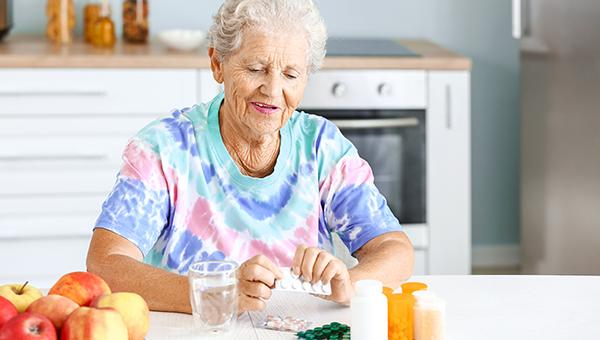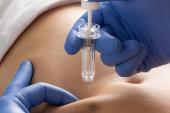MICHELLE Published: Low-Dose Rivaroxaban Cuts VTE Risk After COVID-19 Admission
Rivaroxaban 10 mg/day for 35 days after discharge appears safe and beneficial. Still, editorialists say, larger trials are needed.

For hospitalized COVID-19 patients with a high risk of venous thromboembolism (VTE) and/or elevated D-dimer levels, along with a low risk of bleeding, use of rivaroxaban 10 mg/day for 35 days after discharge is safe and beneficial, the randomized MICHELLE trial shows.
Compared with no anticoagulation, the strategy reduced a composite of symptomatic and asymptomatic venous and arterial thromboembolic events, including CV death (3.14% vs 9.43%; RR 0.33; 95% CI 0.13-0.90), researchers led by Eduardo Ramacciotti, MD (Science Valley Research Institute, São Paulo, Brazil), report.
A link between COVID-19 and both venous and arterial thrombosis was established early on in the pandemic, underscoring the important role antithrombotic therapies would play in its management. Although there’s wide agreement about the need for in-hospital thromboprophylaxis—albeit with some uncertainties about dosing and patient populations—consensus is lacking when it comes to extending antithrombotic therapies to the postdischarge setting.
In that context, the MICHELLE findings, initially presented at the virtual European Society of Cardiology Congress 2021 this past summer and published recently online in the Lancet, provide much-needed randomized evidence to guide clinical decision-making.
Speaking with TCTMD, Ramacciotti said the strategy tested in the trial has been adopted at hospitals across Brazil, where MICHELLE was conducted, as well as in centers in other parts of the world. But he stressed that it is not for all patients hospitalized with COVID-19. A “MICHELLE-able” patient, he said, is one with a high VTE risk assessed using the IMPROVE score, with or without a D-dimer level, and a low bleeding risk. He estimated that roughly half of all hospitalized COVID-19 patients would meet the trial’s inclusion criteria.
In this subset, “it is a good idea to give rivaroxaban 10 mg/day for 35 days posthospitalization,” Ramacciotti advised, adding that at least in Brazil, physicians are focused on using the branded version of the drug (Xarelto; Bayer/Janssen) since generic rivaroxaban wasn’t used in the trial.
The MICHELLE Trial
The extended thromboprophylactic approach tested in MICHELLE was first evaluated in the earlier MARINER trial conducted in prepandemic times among patients hospitalized with an acute medical illness. Though MARINER failed to meet its primary endpoint, low-dose rivaroxaban was shown to reduce the risk of symptomatic VTE, a secondary endpoint.
Based on that finding, Ramacciotti and colleagues opted to try the approach for hospitalized COVID-19 patients in the MICHELLE trial. For the study, the investigators enrolled 320 patients (mean age 57.1 years; 40% women) who were hospitalized for at least 3 days and received standard-dose thromboprophylaxis with heparin during the initial stay; 52% received ICU-level care. All randomized patients had an increased VTE risk based on an IMPROVE score of 2 to 3 (in combination with a D-dimer level above 500 ng/mL) or of 4 or higher (independent of the D-dimer level). Patients with a high bleeding risk—determined by a creatinine clearance below 30 mL/min, use of dual antiplatelet therapy, and other factors—were excluded.
At day 35 after discharge, patients were assessed with Doppler ultrasound and CT pulmonary angiography to identify primary endpoint events, which included symptomatic or fatal VTE, asymptomatic VTE on bilateral lower-limb venous Doppler ultrasound and CT pulmonary angiography, symptomatic arterial thromboembolism (MI, nonhemorrhagic stroke, or a major adverse limb event), and CV death. This endpoint was reduced with rivaroxaban versus no anticoagulation, with the difference mainly due to more cases of asymptomatic and symptomatic pulmonary embolism (PE) in the control arm.
Among secondary outcomes, rivaroxaban reduced the rate of symptomatic/fatal VTE (0.63% vs 5.03%; RR 0.13; 95% CI 0.02-0.99) and a composite of symptomatic VTE, MI, stroke, and CV death (0.63% vs 5.66%; RR 0.11; 95% CI 0.01-0.87).
The key safety outcome was ISTH major bleeding, which did not occur in either group. Other types of bleeds were infrequent and occurred at similar rates in both groups. Two patients in the rivaroxaban arm had allergic reactions to the drug.
Awaiting More Trials
In an accompanying editorial, Charlotte Bradbury, MBBCh, PhD (University of Bristol, England), and Zoe McQuilten, MBBS, PhD (Monash University, Melbourne, Australia), point out the strengths of the MICHELLE trial, including the randomized, multicenter design.
But there are also some limitations, they note, citing the open-label design and the inclusion of some events with “less-clear clinical significance”—like asymptomatic VTE, subsegmental PE, and distal deep vein thrombosis—in the primary endpoint. In addition, the sample size was relatively small and only 20 patients had a primary endpoint event.
Still, Bradbury and McQuilten indicate, MICHELLE helps fill a gap in the literature.
“Before this trial, evidence to inform the use of thromboprophylaxis post-hospital discharge was mostly limited to observational studies,” they say. The MICHELLE results “are encouraging,” they add, “but in view of the small size of this trial, clinicians are likely to wait for results from other ongoing trials . . . evaluating postdischarge thromboprophylaxis before changing standard practice and guideline recommendations,” they add, highlighting HEAL-COVID, ACTIV-4c, XACT, and a 130-patient Mexican trial.
Ramacciotti acknowledged that caution is warranted given the small size of the trial. “Probably in order to change guidelines we will need bigger trials,” he said. “It’s prudent to wait, but we’re not waiting here [in Brazil] because as of now it is the best randomized data we have for this particular population.”
Todd Neale is the Associate News Editor for TCTMD and a Senior Medical Journalist. He got his start in journalism at …
Read Full BioSources
Ramacciotti E, Barile Agati L, Calderaro D, et al. Rivaroxaban versus no anticoagulation for post-discharge thromboprophylaxis after hospitalization for COVID-19 (MICHELLE): an open-label, multicentre, randomised, controlled trial. Lancet. 2021;Epub ahead of print.
Bradbury CA, McQuilten Z. Anticoagulation in COVID-19. Lancet. 2021;Epub ahead of print.
Disclosures
- MICHELLE was an investigator-initiated study with financial support from the Science Valley Research Institute Brazil and Bayer, which provided the study drug and partial financial support.
- Ramacciotti reports grants and consulting fees from Bayer and Pfizer; grants from the Brazilian Ministry of Science and Technology; and personal fees from Aspen Pharma, Biomm Pharma, and Daiichi Sankyo outside the submitted work.
- Related to this topic, Bradbury reports having received speaker’s fees from Bayer for nonpromotional education, and conference funding from Bayer to present research data unrelated to rivaroxaban. Unrelated to this topic, she reports having received speaker’s fees from Amgen, the Bristol Myers Squibb/Pfizer Alliance, Janssen, Eli Lilly, and Novartis; support to attend conferences from Amgen and Novartis; and advisory fees from Ablynx, the Bristol Myers Squibb/Pfizer Alliance, Lilly, Novartis, and Portola.
- McQuilten reports no relevant conflicts of interest.





Comments